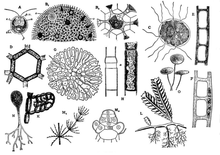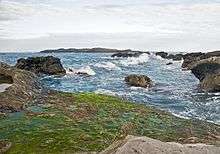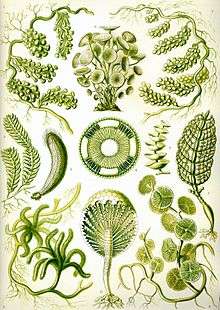Chlorophyta
Chlorophyta or Prasinophyta is a taxon of green algae informally called chlorophytes.[6] The name is used in two very different senses, so care is needed to determine the use by a particular author. In older classification systems, it refers to a highly paraphyletic group of all the green algae within the green plants (Viridiplantae) and thus includes about 7,000 species[7][8] of mostly aquatic photosynthetic eukaryotic organisms. In newer classifications, it refers to the sister of the streptophytes/charophytes. The clade Streptophyta consists of the Charophyta in which the Embryophyta emerged.[9][10] In this sense the Chlorophyta includes only about 4,300 species.[4] About 90% of all known species live in freshwater.[11] Like the land plants (bryophytes and tracheophytes), green algae contain chlorophyll a and chlorophyll b and store food as starch[7] in their plastids.
| Chlorophyta | |
|---|---|
 | |
| Chlorophytes (A–F, H–L and O) | |
| Scientific classification | |
| Domain: | Eukaryota |
| (unranked): | Diaphoretickes |
| (unranked): | Archaeplastida |
| Clade: | Chloroplastida |
| Phylum: | Chlorophyta Reichenbach, 1828, emend. Pascher, 1914, emend. Lewis & McCourt, 2004[1][2][3] |
| Classes[4] | |
| Synonyms[5] | |
| |

With the exception of Palmophyllophyceae, Trebouxiophyceae, Ulvophyceae and Chlorophyceae, which show various degrees of multicellularity, all the Chlorophyta lineages are unicellular.[12] Some members of the group form symbiotic relationships with protozoa, sponges, and cnidarians. Others form symbiotic relationships with fungi to form lichens, but the majority of species are free-living. Some conduct sexual reproduction, which is oogamous or isogamous. All members of the clade have motile flagellated swimming cells.[13] While most species live in freshwater habitats and a large number in marine habitats, other species are adapted to a wide range of land environments. For example, Chlamydomonas nivalis, which causes Watermelon snow, lives on summer alpine snowfields. Others, such as Trentepohlia species, live attached to rocks or woody parts of trees. Monostroma kuroshiense, an edible green alga cultivated worldwide and most expensive among green algae, belongs to this group.
Ecology
Species of Chlorophyta (treated as what is now considered one of the two main clades of Viridiplantae) are common inhabitants of marine, freshwater and terrestrial environments.[14][15] Several species have adapted to specialised and extreme environments, such as deserts, arctic environments, hypersaline habitats, marine deep waters, deep-sea hydrothermal vents and habitats that experiences extreme changes in temperature, light and salinity. [16][17][18][19] Some groups, such as the Trentepohliales are exclusively found on land.[20] Several species of Chlorophyta live in symbiosis with a diverse range of eukaryotes, including fungi (to form lichens), ciliates, forams, cnidarians and molluscs. [15] Some species of Chlorophyta are heterotrophic, either free-living or parasitic.[21][22] Two common species of the heterotrophic green alga Prototheca are pathogenic and can cause the disease protothecosis in humans and animals.[23]
Classifications

Characteristics used for the classification of Chlorophyta are: type of zoid, mitosis (karyokynesis), cytokinesis, organization level, life cycle, type of gametes, cell wall polysaccharides[24] and more recently genetic data.
Phylogeny
A newer proposed classification follows Leliaert et al. 2011[18] and modified with Silar 2016,[25] Leliaert 2016[26] and Lopes dos Santos et al. 2017[27] for the green algae clades and Novíkov & Barabaš-Krasni 2015[28] for the land plants clade. Sánchez-Baracaldo et al. is followed for the basal clades.[29][30][31]
| Viridiplantae/ |
| ||||||||||||||||||||||||||||||||||||||||||||||||||||||||||||||||||||||||||||||||||||||||||||||||||||||||||||||||||||||||||||||
| Green Algae |
Leliaert et al. 2012
Simplified phylogeny of the Chlorophyta, according to Leliaert et al. 2012.[15] Note that many algae previously classified in Chlorophyta are placed here in Streptophyta.
- Viridiplantae
- Chlorophyta
- core chlorophytes
- prasinophytes (paraphyletic)
- Streptophyta
- Chlorophyta
Pombert et al. 2005
A possible classification when Chlorophyta refers to one of the two clades of the Viridiplantae is shown below.[32]
- Class Prasinophyceae T. A. Chr. ex Ø. Moestrup & J. Throndsen
- Class Chlorophyceae Wille
- Class Trebouxiophyceae T. Friedl
- Class Ulvophyceae[33]
Lewis & McCourt 2004
- Division Chlorophyta (green algae sensu stricto)
- Subdivision Chlorophytina
- Class Chlorophyceae (chlorophytes)
- Order Chlamydomonadales (+ some Chlorococcales + some Tetrasporales + some Chlorosarcinales)
- Order Sphaeropleales (sensu Deason, plus Bracteacoccus, Schroederia, Scenedesmaceae, Selanastraceae)
- Order Oedogoniales
- Order Chaetopeltidales
- Order Chaetophorales
- Incertae Sedis (Cylindrocapsa clade, Mychonastes clade)
- Class Ulvophyceae (ulvophytes)
- Order Ulotrichales
- Order Ulvales
- Order Siphoncladales/Cladophorales
- Order Caulerpales
- Order Dasycladales
- Class Trebouxiophyceae (trebouxiophytes)
- Order Trebouxiales
- Order Microthamniales
- Order Prasiolales
- Order Chlorellales
- Class Prasinophyceae (prasinophytes)
- Order Pyramimonadales
- Order Mamiellales
- Order Pseudoscourfieldiales
- Order Chlorodendrales
- Incertae sedis (Unnamed clade of coccoid taxa)
- Class Chlorophyceae (chlorophytes)
- Subdivision Chlorophytina
- Division Charophyta (charophyte algae and embryophytes)
- Class Mesostigmatophyceae (mesostigmatophytes)
- Class Chlorokybophyceae (chlorokybophytes)
- Class Klebsormidiophyceae (klebsormidiophytes)
- Class Zygnemophyceae (conjugates)
- Order Zygnematales (filamentous conjugates and saccoderm desmids)
- Order Desmidiales (placoderm desmids)
- Class Coleochaetophyceae (coleochaetophytes)
- Order Coleochaetales
- Subdivision Streptophytina
- Class Charophyceae (reverts to use of GM Smith)
- Order Charales (charophytes sensu stricto)
- Class Embryophyceae (embryophytes)
- Class Charophyceae (reverts to use of GM Smith)
Hoek, Mann and Jahns 1995
Classification of the Chlorophyta, treated as all green algae, according to Hoek, Mann and Jahns 1995.[7]
- Class Prasinophyceae (orders Mamiellales, Pseudocourfeldiales, Pyramimonadales, Chlorodendrales)
- Class Chlorophyceae (orders Volvocales [including the Tetrasporales], Chlorococcales, Chaetophorales, Oedogoniales)
- Class Ulvophyceae (orders Codiolales, Ulvales)
- Class Cladophorophyceae (order Cladophorales)
- Class Bryopsidophyceae (orders Bryopsidales, Halimedales)
- Class Dasycladophyceae (order Dasycladales)
- Class Trentepohliophyceae (order Trentepohliales)
- Class Pleurastrophyceae (order Pleurastrales)
- Incertae sedis (order Prasiolales)
- Class Klebsormidiophyceae (orders Klebsormidiales, Coleochaetales)
- Class Zygnematophyceae (order Zygnematales, Desmidiales)
- Class Charophyceae (order Charales)
In a note added in proof, an alternative classification is presented for the algae of the class Chlorophyceae:
- Class Chlamydophyceae (orders Volvocales, Chlorococcales, Chaetophorales)
- Class Oedogoniophyceae (order Oedogoniales)
- Class Chlorophyceae (order Chlorellales)
Bold and Wynne 1985
Classification of the Chlorophyta and Charophyta according to Bold and Wynne 1985.[34]
- Chlorophyta, Chlorophyceae (16 orders)
- Charophyta, Charophyceae (1 order)
Mattox & Stewart 1984
Classification of the Chlorophyta according to Mattox & Stewart 1984:[33]
- Micromonadophyceae[33] (similar to Prasinophyceae; Tetraselmidiales transferred to Pleurastrophyceae)
- Charophyceae Rabenhorst
- Ulvophyceae[33]
- Pleurastrophyceae[33]
- Tetraselmidiales
- Pleurastrales
- Chlorophyceae Wille in Warming
Fott 1971
Classification of the Chlorophyta according to Fott 1971.[7]:483
- Class Chlorophyceae
- Order Volvocales
- Order Tetrasporales
- Order Chlorococcales
- Order Ulotrichales
- Suborder Chlorosarcineae
- Suborder Ulotrichineae
- Suborder Oedogoniineae
- Suborder Chaetophorineae
- Order Siphonocladales
- Order Bryopsidales
- Class Conjugatophyceae
- Class Charophyceae
Round 1971
Classification of the Chlorophyta and related algae according to Round 1971.[35]
- "green algae"
- Euglenophyta
- Prasinophyta
- Charophyta
- Chlorophyta
- Zygnemaphyceae (= Conjugatophyceae; orders Mesotaeniales, Zygnematales, Gonatozygales, Desmidiales)
- Oedogoniophyceae (order Oedogoniales)
- Bryopsidophyceae
- Hemisiphoniidae (orders Cladophorales, Sphaeropleales, Acrosiphoniales
- Cystosiphoniidae (orders Dasycladales, Siphonocladales, Chlorochytriales)
- Eusiphoniidae (orders Derbesiales, Codiales, Caulerpales, Dichotomosiphonales, Phyllosiphonales)
- Chlorophyceae
- orders Chlamydomonadales, Volvocales, Polyblepharidales, Tetrasporales, Chlorodendrales, Chlorosarcinales, Chlorococcales
- orders Ulotrichales, Codiolales, Ulvales, Prasiolales, Cylindrocapsales, Microsporales
- orders Chaetophorales, Coleochaetales, Trentepohliales, Pleurococcales, Ulvellales
Smith 1938
Classification of the Chlorophyta according to Smith 1938:
- Class 1. Chlorophyceae
- Order 1. Volvocales
- Family 1. Chlamydomonadaceae
- Family 2. Volvocaceae
- Order 2. Tetrasporales
- Order 3. Ulotrichales
- Family 1. Ulotrichaceae
- Family 2. Microsporaceae
- Family 3. Cylindrocapsaceae
- Family 4. Chaetophoraceae
- Family 5. Protococcaceae
- Family 6. Coleochaetaceae
- Family 7. Trentepohliaceae
- Order 4. Ulvales
- Family 1. Ulvaceae
- Family 2 Schizomeridaceae
- Order 5. Schizogoniales
- Family Schizogoniaceae
- Order 6. Cladophorales
- Family 1. Cladophoraceae
- Family 2. Sphaeropleaceae
- Order 7. Oedogoniales
- Family Oedogoniaceae
- Order 8. Zygnematales
- Family 1. Zygnemataceae
- Family 2. Mesotaeniaceae
- Family 3. Desmidiaceae
- Order 9. Chlorococcales
- Family 1. Chlorococcaceae
- Family 2. Endosphaeraceae
- Family 3. Characiaceae
- Family 4. Protosiphonaceae
- Family 5. Hydrodictyaceae
- Family 6. Oöcystaceae
- Family 7. Scenedesmaceae
- Order 10. Siphonales
- Family 1. Bryopsidaceae
- Family 2. Caulerpaceae
- Family 3. Halicystaceae
- Family 4. Codiaceae
- Family 5. Derbesiaceae
- Family 6. Vaucheriaceae
- Family 7. Phyllosiphonaceae
- Order 11. Siphonocladiales
- Family 1. Valoniaceae
- Family 2. Dasycladaceae
- Class 2. Charophyceae
Research and Discoveries
In February 2020, the fossilized remains of green algae, named Proterocladus antiquus were discovered in the northern province of Liaoning, China.[36] At around a billion years old, it is believed to be one of the oldest examples of a multicellular chlorophyte.[37]
References
- Reichenbach HG (1828). Conspectus Regni Vegetabilis. p. 23.
- Pascher A (1914). "Über Flagellaten und Algen". Berichte der Deutschen Botanischen Gesellschaft. 32: 136–160.
- Adl SM, Simpson AG, Farmer MA, Andersen RA, Anderson OR, Barta JR, et al. (2005). "The new higher level classification of eukaryotes with emphasis on the taxonomy of protists". The Journal of Eukaryotic Microbiology. 52 (5): 399–451. doi:10.1111/j.1550-7408.2005.00053.x. PMID 16248873.
- Guiry MD, Guiry GM (2011). "AlgaeBase : Chlorophyta". World-wide electronic publication, National University of Ireland, Galway. Retrieved 2011-07-26. Cite journal requires
|journal=(help) - Papenfuss GF (1955). "The Classification of the Algae". A century of progress in the natural sciences, 1853-1953. California Academy of Sciences.
- Rockwell NC, Martin SS, Li FW, Mathews S, Lagarias JC (May 2017). "The phycocyanobilin chromophore of streptophyte algal phytochromes is synthesized by HY2". The New Phytologist. 214 (3): 1145–1157. doi:10.1111/nph.14422. PMC 5388591. PMID 28106912.
- van den Hoek C, Mann DG, Jahns HM (1995). Algae An Introduction to Phycology. Cambridge: Cambridge University Press. ISBN 978-0-521-30419-1.
- "Major Algae Phyla - Table - MSN Encarta". Archived from the original on 2009-10-29.
- Lewis LA, McCourt RM (October 2004). "Green algae and the origin of land plants". American Journal of Botany. 91 (10): 1535–56. doi:10.3732/ajb.91.10.1535. PMID 21652308.
- Becker B, Marin B (May 2009). "Streptophyte algae and the origin of embryophytes". Annals of Botany. 103 (7): 999–1004. doi:10.1093/aob/mcp044. PMC 2707909. PMID 19273476.
- Chlorophyta (Chapter 5) - Phycology - Cambridge University Press
- Umen, J. G. (2014). "Green Algae and the Origins of Multicellularity in the Plant Kingdom". Cold Spring Harbor Perspectives in Biology. 6 (11): a016170. doi:10.1101/cshperspect.a016170. PMC 4413236. PMID 25324214.
- Kapraun DF (April 2007). "Nuclear DNA content estimates in green algal lineages: chlorophyta and streptophyta". Annals of Botany. 99 (4): 677–701. doi:10.1093/aob/mcl294. PMC 2802934. PMID 17272304.
- Graham LE, Graham JM, Wilcox LW (2009) Algae. 2nd Edition. Benjamin Cummings (Pearson), San Francisco, CA
- Leliaert F, Smith DR, Moreau H, Herron MD, Verbruggen H, Delwiche CF, De Clerck O (2012). "Phylogeny and molecular evolution of the green algae" (PDF). Critical Reviews in Plant Sciences. 31: 1–46. doi:10.1080/07352689.2011.615705.
- Lewis LA, Lewis PO (December 2005). "Unearthing the molecular phylodiversity of desert soil green algae (Chlorophyta)". Systematic Biology. 54 (6): 936–47. doi:10.1080/10635150500354852. PMID 16338765.
- De Wever A, Leliaert F, Verleyen E, Vanormelingen P, Van der Gucht K, Hodgson DA, Sabbe K, Vyverman W (October 2009). "Hidden levels of phylodiversity in Antarctic green algae: further evidence for the existence of glacial refugia". Proceedings. Biological Sciences. 276 (1673): 3591–9. doi:10.1098/rspb.2009.0994. PMC 2817313. PMID 19625320.
- Leliaert F, Verbruggen H, Zechman FW (September 2011). "Into the deep: new discoveries at the base of the green plant phylogeny". BioEssays. 33 (9): 683–92. doi:10.1002/bies.201100035. PMID 21744372.
- Foflonker, Fatima; Ananyev, Gennady; Qiu, Huan; Morrison, Andrenette; Palenik, Brian; Dismukes, G. Charles; Bhattacharya, Debashish (June 2016). "The unexpected extremophile: Tolerance to fluctuating salinity in the green alga Picochlorum". Algal Research. 16: 465–472. doi:10.1016/j.algal.2016.04.003.
- López-Bautista JM, Rindi F, Guiry MD (July 2006). "Molecular systematics of the subaerial green algal order Trentepohliales: an assessment based on morphological and molecular data". International Journal of Systematic and Evolutionary Microbiology. 56 (Pt 7): 1709–15. doi:10.1099/ijs.0.63990-0. PMID 16825655.
- Joubert JJ, Rijkenberg FH (1971). "Parasitic green algae". Annu. Rev. Phytopathol. 9: 45–64. doi:10.1146/annurev.py.09.090171.000401.
- Nedelcu AM (December 2001). "Complex patterns of plastid 16S rRNA gene evolution in nonphotosynthetic green algae". Journal of Molecular Evolution. 53 (6): 670–9. Bibcode:2001JMolE..53..670N. doi:10.1007/s002390010254. PMID 11677627.
- Tartar A, Boucias DG, Adams BJ, Becnel JJ (January 2002). "Phylogenetic analysis identifies the invertebrate pathogen Helicosporidium sp. as a green alga (Chlorophyta)". International Journal of Systematic and Evolutionary Microbiology. 52 (Pt 1): 273–9. doi:10.1099/00207713-52-1-273. PMID 11837312.
- Lobban CS, Wynne MJ (1981). "The Biology of Seaweeds". Botanical Monograph Series 17. University of California Press: 88. Cite journal requires
|journal=(help) - Silar, Philippe (2016), "Protistes Eucaryotes: Origine, Evolution et Biologie des Microbes Eucaryotes", HAL Archives-ouvertes: 1–462
- Leliaert F, Tronholm A, Lemieux C, Turmel M, DePriest MS, Bhattacharya D, Karol KG, Fredericq S, Zechman FW, Lopez-Bautista JM (May 2016). "Chloroplast phylogenomic analyses reveal the deepest-branching lineage of the Chlorophyta, Palmophyllophyceae class. nov". Scientific Reports. 6 (1): 25367. Bibcode:2016NatSR...625367L. doi:10.1038/srep25367. PMC 4860620. PMID 27157793.
- Lopes Dos Santos A, Pollina T, Gourvil P, Corre E, Marie D, Garrido JL, Rodríguez F, Noël MH, Vaulot D, Eikrem W (October 2017). "Chloropicophyceae, a new class of picophytoplanktonic prasinophytes". Scientific Reports. 7 (1): 14019. Bibcode:2017NatSR...714019L. doi:10.1038/s41598-017-12412-5. PMC 5656628. PMID 29070840.
- Novikoff A, Barabasz-Krasny B (2015). Modern plant systematics. Liga-Pres. p. 685. doi:10.13140/RG.2.1.4745.6164. ISBN 978-966-397-276-3.
- Sánchez-Baracaldo P, Raven JA, Pisani D, Knoll AH (September 2017). "Early photosynthetic eukaryotes inhabited low-salinity habitats". Proceedings of the National Academy of Sciences of the United States of America. 114 (37): E7737–E7745. doi:10.1073/pnas.1620089114. PMC 5603991. PMID 28808007.
- Gitzendanner MA, Soltis PS, Wong GK, Ruhfel BR, Soltis DE (March 2018). "Plastid phylogenomic analysis of green plants: A billion years of evolutionary history". American Journal of Botany. 105 (3): 291–301. doi:10.1002/ajb2.1048. PMID 29603143.
- Rockwell NC, Martin SS, Li FW, Mathews S, Lagarias JC (May 2017). "The phycocyanobilin chromophore of streptophyte algal phytochromes is synthesized by HY2". The New Phytologist. 214 (3): 1145–1157. doi:10.1111/nph.14422. PMC 5388591. PMID 28106912.
- Pombert JF, Otis C, Lemieux C, Turmel M (September 2005). "The chloroplast genome sequence of the green alga Pseudendoclonium akinetum (Ulvophyceae) reveals unusual structural features and new insights into the branching order of chlorophyte lineages". Molecular Biology and Evolution. 22 (9): 1903–18. doi:10.1093/molbev/msi182. PMID 15930151.
- Mattox KR, Stewart KD, et al. (The Systematics Association) (1984). "Classification of the green algae: a concept based on comparative cytology.". In Irvine DE, John DM (eds.). The systematics of Green Algae. 27. London: Academic Press. pp. 29–72.
- Bold HC, Wynne MJ (1985). Introduction to the algae : structure and reproduction (2nd ed.). Englewood Cliffs, N.J.: Prentice-Hall. ISBN 978-0-13-477746-7.
- Round FE (1971). "The taxonomy of the Chlorophyta, 2". Brit. Phycol. J. 6 (2): 235–264. doi:10.1080/00071617100650261.
- EST, Rosie McCall On 2/24/20 at 12:10 PM (2020-02-24). "Billion-year-old green algae found in China is the oldest ever discovered". Newsweek. Retrieved 2020-02-25.
- Sandhya Ramesh (2020-02-25). "Scientists discover world's oldest green algae fossil in China". ThePrint. Retrieved 2020-02-25.
Further reading
| Wikispecies has information related to Chlorophyta |
| Wikimedia Commons has media related to Chlorophyta. |
- Burrows EM (1991). Seaweeds of the British Isles. 2 (Chlorophyta). London: Natural History Museum. ISBN 978-0-565-00981-6.
- Lewis LA, McCourt RM (October 2004). "Green algae and the origin of land plants". American Journal of Botany. 91 (10): 1535–56. doi:10.3732/ajb.91.10.1535. PMID 21652308.
- Pickett-Heaps JD (1975). Green Algae. Structure, Reproduction and Evolution in Selected Genera. Stamford, CT: Sinauer Assoc. p. 606.